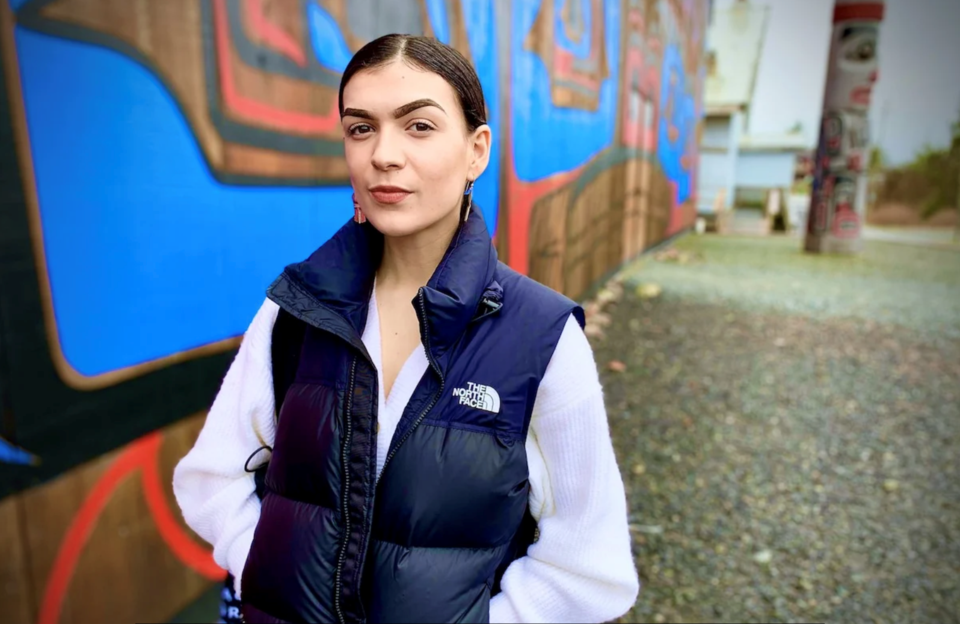Warning: This story contains details that may provoke distress or trauma in some readers.
Astrid Wilson radiates passion, grief and fierce determination when speaking about her ambition to become a fluent Haí╔½zaqvl╠Ża speaker and rekindle the ancestral language of her community of Bella Bella on B.C.’s isolated central coast.
“It’s beautiful, but it’s a heavy journey,” she said.
“When it comes to language revitalization, there are so many emotions that flow through your mind as you’re relearning your language.”
The 19-year-old has nearly finished the first year of an innovative post-secondary immersion program that allows her to learn the language of the Haí╔½zaqv (Heiltsuk) First Nation without having to travel or abandon her home community.
Wilson feels the responsibility and urgency in learning a language that only a small number of elders speak fluently. The pressure to learn it quickly — while elders are still able to pass down the language and oral history of her nation — weighs heavily on her mind.
Stickhandling anger and grief are also part of the learning process, Wilson said.
It’s extremely frustrating to work so hard to wrap your brain and mouth around words and sounds that should have been your birthright, she said.
And there’s the sorrow in understanding the scope of her nation’s loss, Wilson said.
Her grandmother and father, like many in the community, are “silent speakers” — people who understand some Haí╔½zaqvßĖĘa, but have lost the ability to speak it after being forced to attend residential schools designed to repress and erase Indigenous language and culture.
“It’s like a stab in the chest knowing that I get to learn my language when my Nana had hers beaten out of her,” she said.
Wilson works to overcome her emotions and relishes the learning effort as a conscious act of resistance — because colonizers would have wanted her to surrender to the pain of the process.
“They would have wanted you to be angry, angry at yourself and with your identity,” she said.
Revitalization translates as resistance and reconciliation
Q╠ōátuw╠ōas Brown graduated from the first year of the 900-hour inaugural Haí╔½zaqvl╠Ża immersion program last year and is eagerly waiting to begin the second year of the program along with Wilson and her classmates in September.
The program is especially valuable for recent high school graduates who can now remain in Bella Bella to get in-person learning in their ancestral language and accumulate post-secondary credits, Brown said.
Language learning is more than academic, Brown said. It’s critical to the Haí╔½zaqv First Nation’s future and well-being.
“We’re doing the best we possibly can in our current situation of ongoing colonization,” said Brown, who has written poetry about her experience in the language revitalization program.
Invaluable history, knowledge and culture are encoded in Haí╔½zaqvl╠Ża, Brown added.
And due to its importance, language revitalization is referred to as a λiác╠ōi, a “house post” — a key priority in the unique reconciliation agreement recently finalized by the nation and the B.C. government.
The five-year revitalization plan is ambitious, aiming to ensure the language is used conversationally in a wide variety of contexts in the community from cradle to grave. As well, there will be heavy investment in training for teachers and fluent speakers and other immersion programs throughout the community. Concrete goals include doubling the number of fluent speakers in the community and elevating 30 silent speakers to fluency.
There’s also the continual development of a host of digital and online learning resources.
One of the immersion program instructors, G╠īvu╠ōí Rory Housty, regularly uses social media like Twitter and TikTok to teach Haí╔½zaqvl╠Ża.
As does Brown herself on Instagram, who teaches yoga classes incorporating Haí╔½zaqvl╠Ża.
nú╔½císta’ila qß╣ćts n╠ōálay╠ōax╠ī - our weather is crazy/acting nonsensically aka
— Hai╠ü╔½zaqvl╠Ża (@hailhzaqvla)
In addition to the adult immersion program, there is a children’s “language nest” and a pilot program planned for silent speakers that will simultaneously work on the trauma often tied to speaking Haí╔½zaqvßĖĘa, Brown said.
There are generations of people in her community who were punished for using their language, so some people have a negative association with speaking Haí╔½zaqvl╠Ża, she said.
“The silent speakers program is essential and will work through the trauma and bring healing and light to our nation.”
It’s a critical time because there’s little direct transmission of Haí╔½zaqvl╠Ża from parent to child in the community, a concern for Brown who is planning to have children in the immediate future.
“The only way I get to gift my future children the language of their ancestors is if I learn it first,” she said.
Wilson is also heavily motivated to learn her Indigenous language through her commitment to children — her own into the future, those in her immediate family and those in the community.
Her dream is to combine her Haí╔½zaqvl╠Ża diploma with a master’s degree in education and teach youth on the land in Haí╔½zaqv traditional territory where so much of the language is rooted.
“I’m not doing this only for myself, but for my family and others who couldn’t have the opportunity to learn,” she said.
“But there’s also a new opportunity to rewrite history by learning our language every day.”




